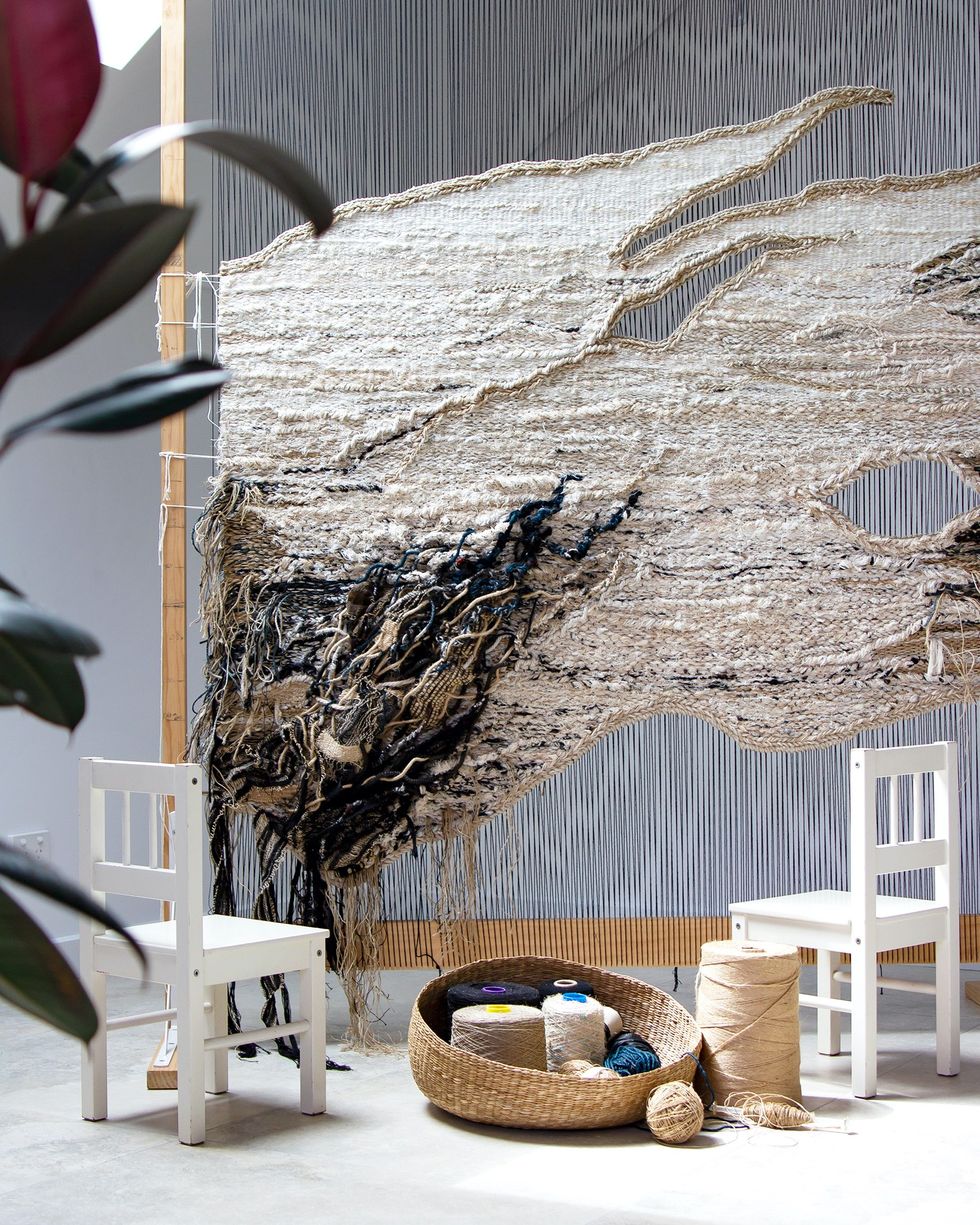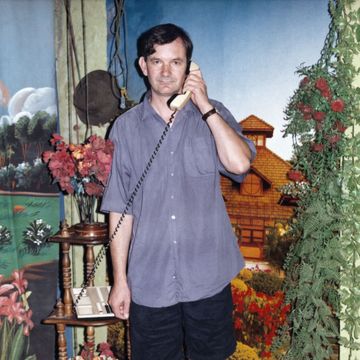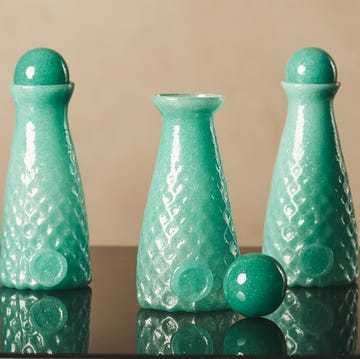Tapestries are having a moment, with more of us than ever seeing how this most tactile form of artistry can make a unique decorative statement in homes. Not only does a tapestry have more warmth than a print when hung on your wall, it also shows the hand of its maker.
And those makers can be very different from one another. The work created by our four new-generation tapestry artists differs wildly aesthetically, but it’s the therapeutic nature of the pieces they create that is key to their creativity – and its charm.
Crossing Threads
Known for their large-scale, handwoven pieces, Sydney-based sisters Lauren and Kass Hernandez, otherwise known as Crossing Threads, first came to weaving via an introductory workshop in 2015. ‘We immediately caught ‘‘weaver fever’’,’says Lauren. ‘The hobby grew into a side hustle via interest from our Instagram profile. Growing up we both danced, so we watched our parents embellish our costumes and visited countless fabric stores. Creating fibre art in adulthood reignited that interest, and eventually it evolved from a passion project into a business.’
What's everyone reading?
Experimentation led the pair to develop their recognisable ‘interknot’ technique, which uses hand-knotted chains of varying thickness, intertwined to create a textural, relief surface. Pieces are woven using natural materials such as Australian merino wool and plant-based fibres, as well as upcycled and dead-stock fabrics and found items not typically used in textile art.
‘You might find the odd zipper or denim seam in our pieces,’ says Lauren. ‘Breathing new life into old is one way we can reduce textile waste, but it also challenges us to be more innovative. We also love to embed objects and mementos that our clients have collected, weaving their story into the mix.’
Relationships and experiences also influence the duo’s work, as do the beach, the ocean and organic patterns such as bark, rock formations and fallen leaves. ‘MotherNature always gets it right with her colour palettes and texture combinations,’ notes Lauren.Currently, the sisters are wrapping up a large-scale commission for a beachside home in New Zealand. ‘It’s the widest we’ve ever created, at 240cm,’ says Lauren. ‘We have commissions from clients in Sydney and the US, and our next collaboration will explore felted merino and sculptural elements.’ crossingthreads.co
Jo Elbourne
A spool of charity-shop rope was the starting point for Jo Elbourne’s artistic journey, which sees her create graphic textile work using simple cord. ‘I didn’t have a plan, but I had dining chairs where the seats pushed out, so I wrapped the rope around the frames,’ she explains. ‘I was out of work, and unexpectedly in a new town, with time on my hands but not much by way of resources, so everything involved accessible, affordable materials like string, gardening twine or washing line.’
Moving on to secondhand stools, she pared back the weaving process to be as uncomplicated as possible. ‘There was something therapeutic about it,’ she says.‘I hadn’t done hands-on projects since college, so it felt both new and familiar.’ Elbourne studied fashion at Ravensbourne College, eventually focusing on menswear. ‘Back then, there were more ‘‘rules’’ than with womenswear, and limitations suited me. I learned about proportion, and how a minimal change to a measurement or detail could alter the look of the whole piece. Those things still inform my practice.’
Now working from a converted warehouse in Margate, Elbourne won an ELLE Decoration British Design Award in 2017, and subsequent projects include a piece for Haeckels House, rugs and limited-edition art with design studio The Ninevites, as well as larger-scale pieces for a collaboration that’s still under wraps. Next comes an exhibition at Rodić Davidson architects in Bloomsbury, and also in the pipeline is work for Otomys, a Melbourne-based gallery whose roster she is joining in 2023.
‘I love the rhythm of the process, and there’s something satisfying about creating a rigid surface using a soft material,’ Elbourne says. ‘The restorative element is still the best part for me, and I’m very committed to ensuring the making remains as enjoyable as possible.’ jorobynelbourne.com
Dalia James
Having opted to study printed textiles at Loughborough University, Dalia James, who graduated in 2012, switched to woven textiles in her second year. ‘I was way more into what the weavers were doing!’ she laughs. ‘I found the translation of their research into cloth really interesting, and I liked the practical nature of the craft. I’m from a creative family; my mother spent hours teaching me to make things, so I like using my hands. I’m also a history nerd and I love the idea of taking an ancient craft and making contemporary work, and the fact that you start with a bunch of yarns then end up with a three-dimensional object.’
Based in Walthamstow, east London, James weaves on looms and dip-dyes her yarns by hand, so the vibrant colours take on a hazy, ikat-like effect and no two pieces are ever identical. Inspired by the Bauhaus, architecture and art, she uses biodegradable materials such as bamboo, wool and silk, and is experimenting with SeaCell, a fibre made from seaweed.
Part of lifestyle brand Toast’s New Makers programme for 2022, James is now represented by London’s Cavaliero Finn Gallery. Plans include applying for an Arts Council grant to create an installation in 2024 for Collect Open, a platform that pioneers rising artists at the Crafts Council’s influential fair, Collect. ‘I’d like to design a range of textiles that can be produced by a micro factory,’ she says. ‘And I’d love to work with a furniture maker on statement pieces using my fabrics.’ @daliajamesstudio
Paola Rodriguez
‘I grew up in a country where craftsmanship plays an important role, and textiles were always in my family – my great-grandfather owned a fabric store and both my grandmothers were always knitting and embroidering,’ says Bogotá-born artist Paola Rodriguez. ‘I learned to knit when I was young, so yarn is a material I’m very familiar with, and it has both a physical and an emotional warmth.’
Having studied jewellery design and ceramics, in 2014 Rodriguez launched her own line of womenswear, but after five years in that fast-paced industry felt the need to reconnect with making. ‘I had leftover materials I wanted to use in a non-traditional way, so that led me to my current method of working – a trial-and-error process until I reached a certain flow,’ she explains. ‘I use paint and fabric, but mostly coiled yarn. It has an ‘‘alive’’ quality and is springy, malleable and captures the light well. The journey was very organic.’
Inspiration comes from a rediscovered love of photography, as well as craft-led artists including Ruth Asawa, Olgade Amaral and Ethan Cook, and photographers Saul Leiter, Luigi Ghirri and Vivian Maier. ‘In terms of composition, I love surrealists like Eileen Agar and Joan Miró, as well as the contemplative nature of Onchi Koshiro.’
She was a finalist in Partnership Editions’ Open Call competition, and her work is available there and via Uprise Art in New York, and Craft Gallery in Paris, which sells limited-edition prints. ‘I’m also finishing pieces for Art Basel Miami’s Scope show, and have compositions in my sketchbooks that need work,’ Rodriguez says. ‘The making process is slow, therapeutic and contemplative; I become very aware of my thoughts and energy. In that time, I let go and become fully present.’ paolarodriguez.com

























